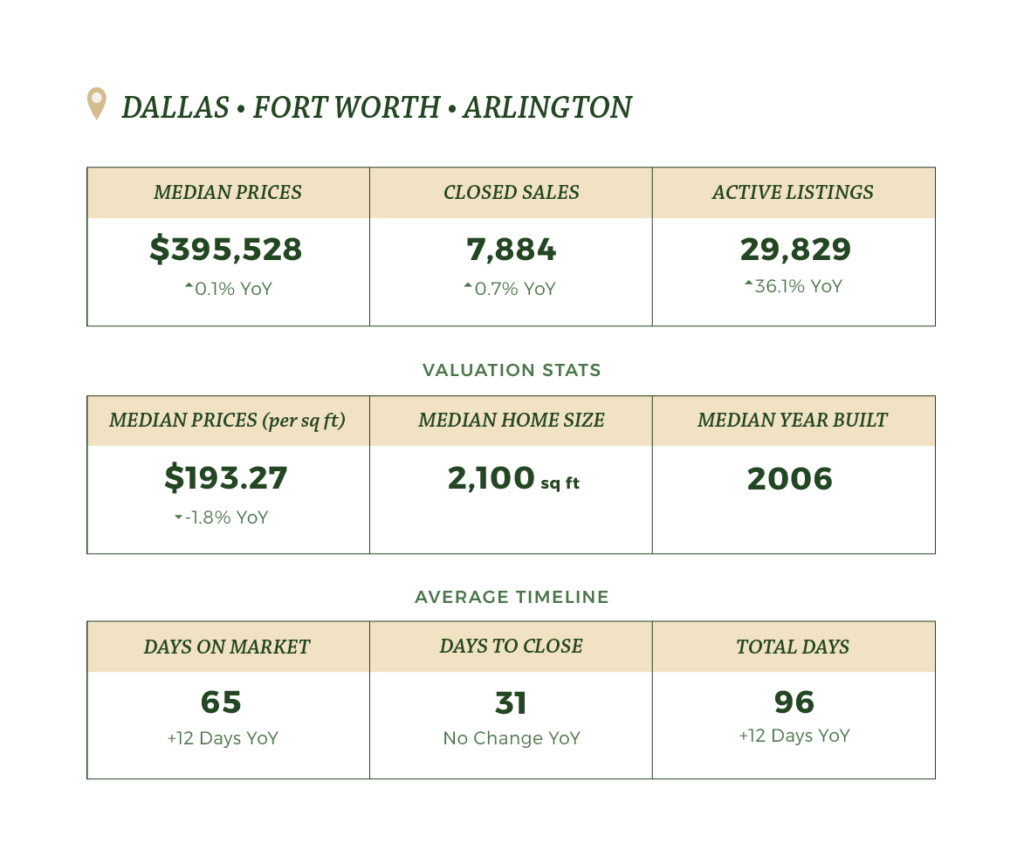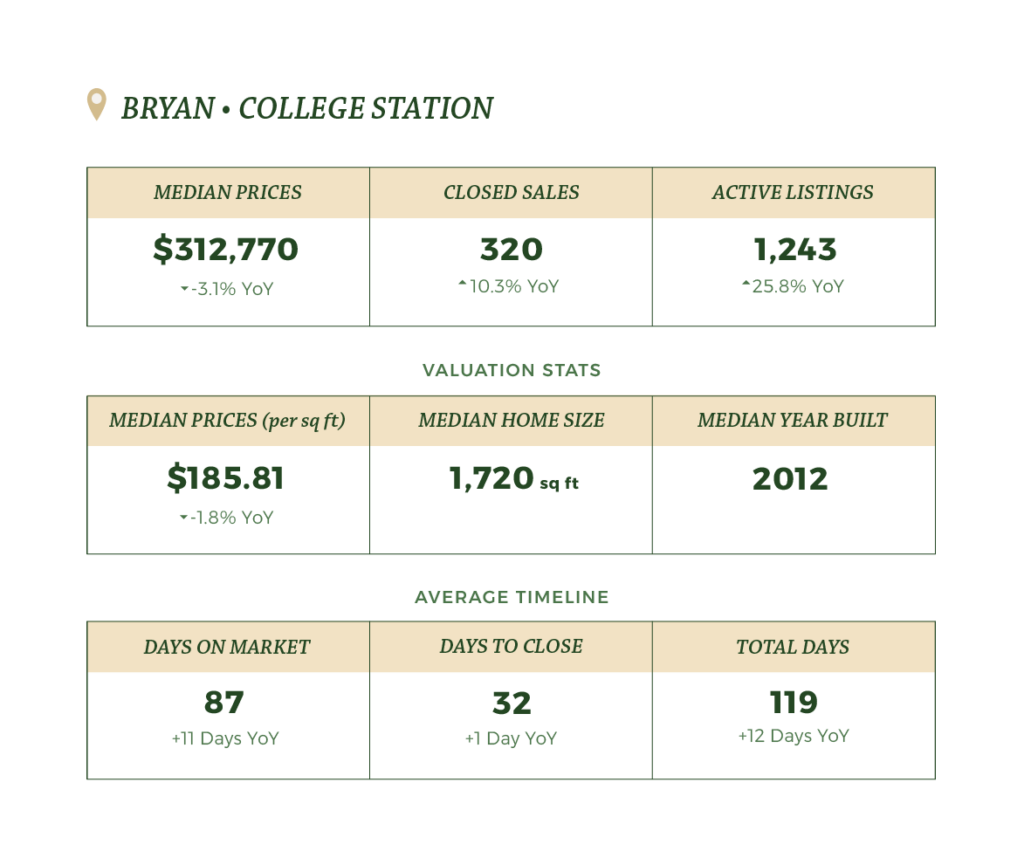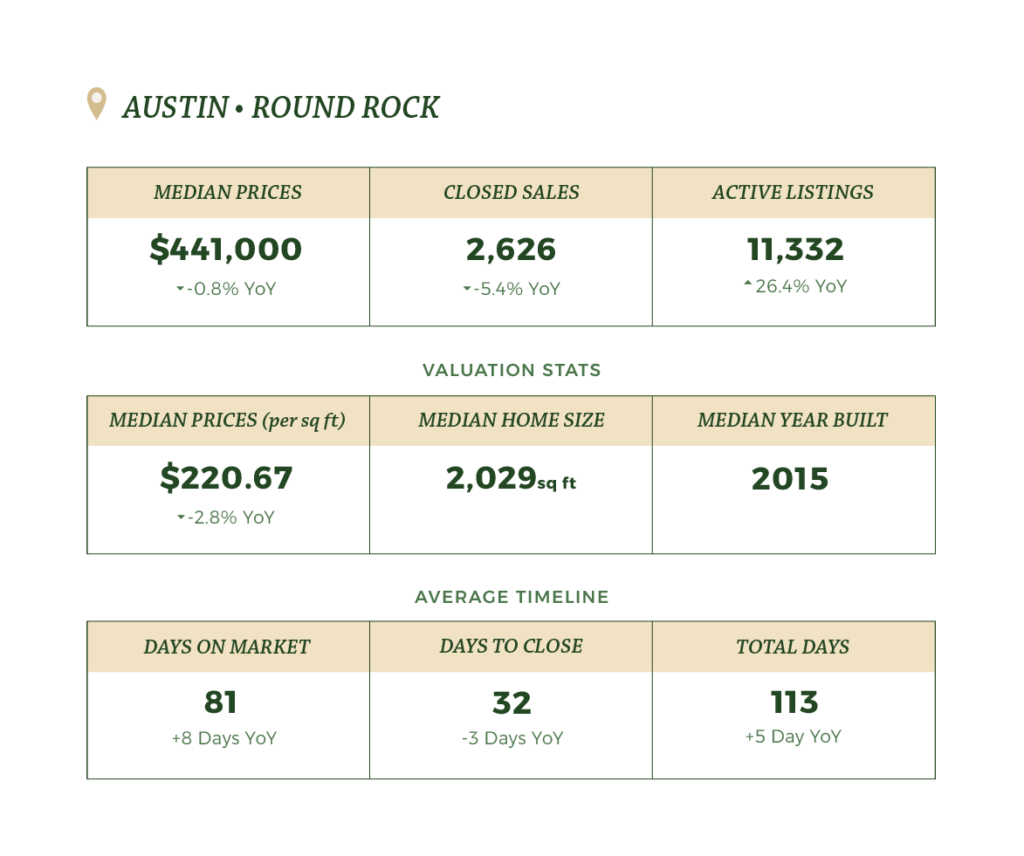Dallas • Fort Worth • Arlington
College Station • Bryan
Austin • Round Rock
Houston • The Woodlands • Sugarland

Dallas-Fort Worth-Arlington MSA
Residential
The Dallas-Fort Worth residential market exhibits signs of maturation with price stabilization and modest transaction growth. The substantial 36.1% increase in active listings has created a more balanced market environment, though the 3.9 months of inventory indicates conditions still marginally favor sellers.
Property values have largely plateaued, with minimal price-per-square-foot changes year-over-year. This normalization follows the extraordinary appreciation of 2021-2022 and represents a healthier, more sustainable market trajectory. Transaction timelines remain efficient with properties averaging 65 days on market and closing at 95.2% of original list price.
Rural Land
The rural land market surrounding Dallas-Fort Worth presents a complex investment landscape characterized by strong price appreciation amid declining transaction volume. Land values have increased 3.89% year-over-year to $8,475 per acre – maintaining the highest five-year compound annual growth rate in Texas at 11.66%.
This price growth despite significantly reduced transaction volume (down 28.26% to the lowest level since 2013) indicates highly selective market demand focused on premium properties. The typical transaction size has increased to 117 acres while total acreage sold has contracted substantially, suggesting a flight to quality among rural land investors.
This divergence between price trends and transaction metrics presents sophisticated opportunities for investors who understand the nuanced dynamics of this market segment.

College Station-Bryan MSA
Residential
The College Station-Bryan residential market presents a complex picture of price correction coupled with transaction growth. The 3.1% year-over-year decline in median prices has stimulated market activity, with closed sales increasing 10.3% and inventory levels expanding to provide 4.6 months of supply.
This price adjustment appears to have catalyzed renewed market interest, with properties still achieving 95.9% of original list price despite longer market exposure averaging 87 days. The education-anchored economy of this university town provides fundamental stability despite short-term price fluctuations.
Rural Land
The College Station-Bryan area’s rural land market shares the broader Gulf Coast-Brazos Bottom region’s strong performance metrics. The contrast between declining residential values and appreciating rural land prices in this region presents strategic opportunities for portfolio diversification.
The stability provided by Texas A&M University creates unique investment dynamics in this market, with rural land potentially serving as an inflation hedge against short-term residential price adjustments. The increasing transaction volume and parcel sizes indicate growing investor confidence in the region’s agricultural and recreational land values.

Austin-Round Rock-San Marcos MSA
Residential
The Austin residential market continues its recalibration from previous peak valuations, with median prices showing a modest 0.6% year-over-year decline amid reduced transaction volume. The 26.4% increase in active listings has normalized inventory levels to 4.5 months, creating more balanced negotiating conditions.
Price per square foot has declined more significantly (-2.8%), indicating adjustments in the premium segment of the market. Properties now average 81 days on market – considerably longer than during the market’s peak – though still achieving 94% of original list price. The underlying economic fundamentals of the region remain strong despite this market normalization.
Rural Land
The Austin-Waco-Hill Country rural land market demonstrates resilience amid residential market adjustments, with modest price growth of 0.95% year-over-year to $7,203 per acre. More significantly, transaction activity has rebounded substantially with sales volume increasing 11.06% and total acreage sold expanding by nearly 16%.
This region has shown the most pronounced improvement in rural land market activity from the low point in Q4 2023, with total dollar volume increasing 17.07% to $349 million. The five-year compound annual growth rate remains impressive at 11.42%, underscoring the long-term investment value of rural properties in this region.
The divergent performance between Austin’s residential and rural land markets creates strategic opportunities for investors seeking to reallocate capital within this high-demand region.

Houston-Pasadena-The Woodlands MSA
Residential
The Houston residential market displays modest growth trajectories with median prices increasing year-over-year while maintaining reasonable transaction timelines. The substantial increase in inventory levels signals a shift toward more balanced market conditions, providing buyers with enhanced negotiating leverage not seen in recent years.
With months of inventory expanding to 4.6 and properties selling at 94.6% of original list price, the Houston market is recalibrating toward sustainable growth patterns after the volatility of recent years. Price appreciation continues, albeit at a more moderate pace, indicating the fundamental strength of the region’s housing demand.
Rural Land
The rural land market surrounding Houston has demonstrated remarkable resilience, breaking through previous price ceilings to reach $10,001 per acre. This 4.46% year-over-year increase has occurred alongside healthy transaction volume growth, creating one of the most balanced rural recoveries in the state.
The expansion in typical parcel size to 151 acres and nearly 10% growth in total acreage sold indicates robust investor confidence in the region’s long-term prospects. With total dollar volume approaching $200 million, the Houston rural land market represents a significant opportunity for strategic diversification within real estate portfolios.
This synchronized improvement in both price and transaction metrics distinguishes the Houston region from other Texas markets where these indicators often move in opposite directions, suggesting particular economic strength in this area.
Market Outlook
The Texas real estate market is navigating a transitional period characterized by several key trends that sophisticated investors should monitor:
- Sectoral Divergence: The varying performance between residential and rural land markets within the same geographical regions creates opportunities for strategic portfolio rebalancing.
- Inventory Normalization: The substantial increase in residential inventory across all metropolitan areas has reintroduced negotiating leverage for buyers without triggering significant price corrections.
- Regional Differentiation: Market performance now shows greater variation by region than at any point since the pandemic, requiring location-specific investment strategies rather than broad-market approaches.
- Rural Land Recovery: The improvement in rural land transaction volumes across five of seven Texas land regions suggests the beginning of a sustainable recovery in this asset class.
- Monetary Policy Impact: The Federal Reserve’s rate adjustments in late 2024 are gradually influencing market dynamics, with full effects likely to materialize through mid-2025.
For the remainder of 2025, the Texas Real Estate Research Center anticipates continued moderation in price trajectories as markets seek sustainable equilibrium. The implementation of new federal economic policies presents both opportunities and challenges that will shape market performance in the coming quarters.
For investors and homebuyers, understanding these regional and sectoral variations will be crucial for identifying value in this increasingly nuanced market environment. Professional guidance from local market experts remains essential for navigating these complex conditions successfully.
Learn More
The Texas Real Estate Research Center is a valuable resource for real estate professionals, investors, and anyone interested in learning more about the Texas real estate market.

